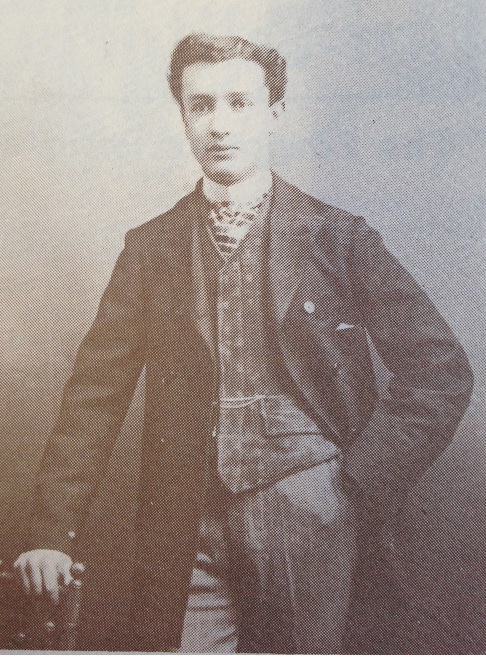This issue: Contents
Tuesday, August 9, 2016
- Editor’s Note
- WCHS News: An Outdoor Movie and Egyptologists – Later This Week!
- WCHS News: Washington County History Network Meeting
- What Is This Thing?!
- Old News: A Glimpse Over the Wall
- Featured Article: Edward Duffield Neill: Pioneer, Historian, Reverend, Ambassador
Hello, hello, hello! Hope you are all having a fantastic week so far! Thank you for letting our humble e-newsletter be part of it!
Last Sunday, the Warden’s House was packed with folks eager to learn a bit about the James-Younger Gang’s raid on the Northfield Bank from Northfield Historical Society director Hayes Scriven. Here’s a quick video recap (1:22) of what Hayes had to say, in case you missed it.
And of course this past week was the Washington County Fair! Hopefully you got a chance to swing by our booth! Whew! It’s been a busy few weeks and it’s just going to continue being busy!
Check out today’s first News Story to learn about the TWO FREE programs coming up later this week!
In our second News story, we’ll check in with the other historical organizations of Washington County to see what’s going on in their neck of the woods.
Last week’s “What Is This Thing?!” was a tricky one! Find out what exactly it was and see a new challenge just down the page.
It’s no secret that, I’ve always found the Stillwater Prison absolutely fascinating. Well, it’s just my luck that on this date in 1872, a reporter decided to publish an in-depth analysis of Stillwater’s most famous institution. Head down to the Old News section to hear a slice of 19th century prison life.
Finally, we’ll wrap up today’s Historical Messenger with a look at an extremely ambitious and multi-talented character of Minnesota’s past: Edward Duffield Neill.
Seriously, you need to read about everything this guy got up to in his life. From creating one of Minnesota’s most well respected universities to rubbing elbows with three Presidents…Dr. Neill accomplished quite a bit!
We are also now accepting advanced reservations to our Fall Membership Meeting.
Sean Pallas
Historical Messenger editor and Warden’s House Site Manager
sean.pallas@wchsmn.org
WCHS News
An Outdoor Movie and Egyptologists – Later This Week!
 Outdoor Museum Movie Night Presents: Gulliver’s Travels – Thurs. August 11th @ 7:30 PM – Hay Lake School, Scandia
Outdoor Museum Movie Night Presents: Gulliver’s Travels – Thurs. August 11th @ 7:30 PM – Hay Lake School, Scandia
Note: This event will be rescheduled if thunderstorms are in the area.
How many remember going to the drive-in movie theater as a kid? In 2016, drive-in movies are on the decline and the younger generation may never get the chance to feel what it’s like to watch a movie under the stars. This is a chance for all to enjoy that feeling again. The Hay Lake School grounds allow us to project 1939’s “Gulliver’s Travels” on the side of the museum, so all attendees can enjoy the feeling of watching a movie outside.
Free tours of the museum begin at 7:30pm, show time of the film will begin at dusk. Attendees are encouraged to bring a chair or blanket to sit on for the duration of the event. There is even room on the grounds to park a few cars to truly give it that “drive-in movie feeling.” Concessions will be available (popcorn, candy, soda, water, etc.) with all funds going to the Washington County Historical Society.
Gulliver’s Travels is based on seaman Lamuel Gulliver who is the sole survivor of a shipwreck in a distant land whose people are no bigger than peanuts, adventure then ensues. With a run time of 76 minutes, Gulliver’s Travels is a great time for both children and adults. Children will enjoy the music and animated nature of the film while adults will enjoy the “it’s so bad its good” feel to this 1939 classic.
 Ancient Egypt Was Built From Here – Sun. August 14th @ 2:00 PM – Warden’s House Museum, Stillwater
Ancient Egypt Was Built From Here – Sun. August 14th @ 2:00 PM – Warden’s House Museum, Stillwater
Join Dr. Maria Nilsson and John R. Ward archaeologists, founders of the “Friends of Silsila“, & hosts of “Egypt’s Treasure Guardians” on National Geographic, for a discussion of the extraordinarily important ancient Egyptian site, the sandstone pits at Gabel el-Silsila.
Gebel el-Silsila is situated along the Nile River in Egypt and was used as a major quarry from ca. 1500 BCE all the way to around 200 CE. Many of the most famous and powerful pharaohs ordered the construction of ancient Egypt’s most well known temples, such as Luxor and Karnak, from the sandstone harvested at Silsila.
Dr. Nillson and Ward have spent years heading the first ever-comprehensive archaeological survey of the site. Their team’s latest discovery is pinpointing the location of a previously lost 3,400-year-old, 18th dynasty necropolis.
More Events
WCHS News
Washington County History Network
Yesterday, representatives of more than a half-dozen historical organizations from around the county met at the Historic Courthouse in Stillwater. I would like to take a moment to share a bit of what was discussed:
Afton Historical Society: An archaeological survey was performed of the rattlesnake mound site near Afton. Since no Native American artifacts were discovered, the planned storm sewer work will continue. The current exhibit at the museum is highlighting Early Farming Life in Afton and will be up until Mid-October (and includes a life-sized horse!) The Afton Historical Society will now be managing and maintaining Mt. Hope Cemetery.
Cottage Grove Historic Preservation Committee: There will soon be a new Fire Department station in Cottage Grove and the hope is that a display will be designed highlighting the history of that community’s fire department. A book was also recently uncovered that was apparently a gift given by Cottage Grove’s first resident: James Sullivan Norris.
Denmark Township Historical Society: On August 16th, Ken Martens will be hosting a program about the Burial Mounds of the area. The Historical Society is also pursuing $10,000 grants to support the restoration of the Valley Schoolhouse.
South Washington County Heritage Society: In June, the Heritage Society visited both the Minnesota’s Landscape Arboretum and the “Purple Palace” – the late Prince’s home. On the second Saturday of September, Wallace Webber, a retired Northwest Airlines pilot will be giving a talk on the history of that company. And on the second Saturday of November, Jim Sullivan, a veteran and member of the honor procession for funerals at Ft. Snelling will help commemorate Veteran’s Month at the Heritage Society.
Stillwater Library: Many historical documents are being digitized including Stillwater Bridge paperwork dating from 1890 to 1899.
Washington County Historic Courthouse: The Courthouse will be hosting another “Stillwater History Hike” on August 27th. Also, the always popular Nooks & Crannies Tours will be held October 2nd. New to the tour this year is the 1870s jail that housed women and juveniles in the prison! Speaking of prison, the staff has decided to extend the run of their popular Prohibition exhibit until early 2017. So go check it out if you haven’t had a chance to yet! Finally, next year will be the Courthouse’s 150th birthday – so keep an eye out for big events to celebrate this milestone!
Woodbury Heritage Society: Next year is Woodbury’s 50th anniversary as a city! The Heritage Society is creating a map of all the historic markers in the city for locals and visitors alike. The Heritage Society is also raising funds to hire a structural engineer to inspect the Miller Barn to determine what steps would be necessary to preserve this historic site. They are also hoping to have the barn placed on the National Register of Historic Places.
More Events
What is This Thing?!

What Is This Thing?! (Round 42)
So just about everyone who took a guess at last week’s What Is This Thing?! figured it was some kind of fancy candy dish. And I suppose you could use it as such…
But it’s intended purpose was as a calling card tray! “Calling cards” are one of those curious Victorian traditions that have vanished over the years. Like much of their culture, social interactions were very formal and ritualized from the mid-1800s to the turn of the 20th century…especially for rich folks.
As socialites made the rounds in their local circles, both men and women would carry extremely ornate calling cards to leave at the homes they visited. Any respectable household would collect these cards and leave them in a silver tray near the front of their home so other guests could see how popular they were! Sort of like the Victorian Facebook I suppose!
Here’s a pretty good website showing lots of examples of calling cards and explaining some of the nuances of the practice.
As always, thanks for participating in last issue’s challenge!
Now…for today’s item…first off, you should ignore the little piece of white paper. This curious instrument just happens to have its name written on the front of it. And that wouldn’t make it very fun! Secondly, you’ll see a few more angles below.
Can you identify the WCHS artifact photographed above? If you’d care to venture an answer, you can send an email to me at spallas.wchs@gmail.com, tweet @WCHSMN, or post your guess on our Facebook page.
Good luck!
Full Image
Side Image
Old News
A Glimpse Over the Wall
It’s one thing to read a history of the Old Stillwater Prison. I’ve ready plenty of that.
I’ve even had the opportunity to read reports from the convicts on the details of prison life. Similarly, there are plenty of records from guards and staff detailing their experiences with the penitentiary.
However, all of the above are written for an audience that is expected to arrive with a certain amount of knowledge of the facility. This lengthy article is a truly interesting take on the subject from a complete outsider written for other outsiders.
It might be a surprise to a modern reader the completely positive and complimentary tone of the article. One interesting note is that not too long after this, Minnesota changed it’s laws regarding inmate labor. Due to pressure from free laborers, 1872 would have been one of the last years where inmates were permitted to be “farmed out” to enterprises outside the prison walls.
The State Prison: Who Are In It & How It Is Conducted – Stillwater Messenger – August 9, 1872
The writer remembers how, when he was a very little boy, he could hardly be induced to enter the yard of a certain prison, because he feared some of the blood-thirsty murderers confined therein would pounce upon and kill him out of pure fiendishness. He did not know that criminals, even very wicked ones indeed, could be tamed down by prison discipline into persons of quiet and inoffensive manners. Nor was he aware that a prison yard was one of the quietest and best regulated enclosures in the world.
All prisons, however, are not as well regulated, as is the one at Stillwater – a circumstance not to be wondered at, since all prisons have not a Mr. Jackman for warden.
Probably but a small portion of the readers of the MESSENGER have ever taken the trouble thoroughly to inspect the important establishment which our city has the honor to possess. It is presumable, therefore, that some account of the same may furnish interesting and profitable reading.
The Cells
The prison will accommodate conveniently about one hundred and fifty-eight convicts. It has eighty-eight inmates at the present time. There are five tiers of cells, one above another, each cell designed for one occupant. It is furnished with a bed, single width, a wash stand, basin and water jug, bath tub, &c. In the winter each cell has a lamp, which, however, must be extinguished by eight o’clock. The cells are ventilated in the following manner: Near the floor is a small closet, large enough to hold a commode and furnished with a tight door. These closest are connected with large air chimneys by means of iron tubes. Near the top of the cell is a round aperture, which also communicates with the large air chimneys by means of iron tubes. When the windows in the halls are opened – and they are kept open as much as the weather will permit – the current of air up the ventilator is strong enough to carry up a piece of tissue paper.
The halls and cells are frequently whitewashed, and the floors are swept daily. The cleanliness and good ventilation of the prison are in striking contrast to the filth and noxious atmosphere, which too often pervade similar institutions.
Female Department
The cells for female convicts are larger than the others, and fewer. At present none of them are occupied. This circumstance led to a passage of wit recently, between the warden and a young lady visitor to the prison.
“The fact hat none of the female cells are occupied,” remarked the lady, “shows conclusively that women are better than men.”
“Nay,” quoth the warden, “it only shows that men are so gallant that ‘tis next to impossible to get twelve of them to agree in convicting a woman of a serious misdemeanor. When the day of woman suffrage comes, and women sit on juries, we shall find these vacant cells very necessary.”
The Daily Routine
At this season of the year, the prisoners are required to rise at half after five, to breakfast at six, and to commence work at half after six. Their hours of labor average ten and one-half hours through the year. Their meals are served to them in tin trenchers, which are rectangular in shape, and are divided into three compartments, in order that the different articles of food may be kept separate.
The food is abundant and of good quality. It is not doled out by either weight or measure, but each man has all he wants. A great deal of fresh beef is used, also corned beef, pork, beans, bread and soup. On Friday fish is substituted for meal, partly for the sake of variety, and party in deference to the wishes of the Catholic members of the family. Half an hour is allowed for each meal. Coffee is furnished in the morning and ta at night; water for dinner, except in special cases. It is safe to say that many a lad fares better in the prison than he ever did out of it.
The convict labor is “farmed out” by the State to the highest bidder. Messrs. Seymour, Sabin, & Co. are the gentlemen who have contracted for this labor, their lease having been renewed recently as to extend nine years form the present time. They pay the State forty-five cents per day for each man. This rate is not as high as is paid in some states, nor as low is paid in others. The average rates are about fifty-one cents, which is low enough certainly; for although a few earn no more than that, the majority earn a much larger sum.
When a convict is brought in he is furnished with a zebra suit, and after a short time set at work in some one of the various departments of mechanical labor.
If he is insubordinate either then or subsequently, he is disciplined by confinement in the dungeon, on reduced fare. This method of discipline is, in Mr. Jackman’s opinion, the best that has yet been devices. Corporal punishment enrages a man. It wounds his vanity, fires his brain, and excites his animosity. It fact, it stimulates for the time. All the evil that is in him. On the other hand, confinement, accompanied by a diet of bread and water, induces reflection, draws the blood from the head, and cools the blood. A man seldom holds out beyond the third day, and leaves the dungeon without any revengeful feeling toward the officers. All the prisoners are obliged to shave once a week.
Featured Article
Edward Duffield Neill: Pioneer, Historian, Reverend, Ambassador
by Betty Roney
 Beginning in Denmark Township at the southern tip of Washington County, a road hopscotches north until it halts in Stillwater Township a few miles beyond Minnesota Hwy 96. Its original name some say, was “Prairie”. Its present name was chosen in the late 1960s, when the alphabetical Capitol grid plan became effective. That’s when some non-historian labeled it “Neal Avenue”. It means nothing except that it follows Manning and precedes Oakgreen. And yet, it could mean a great deal, spelled differently, but pronounced the same.
Beginning in Denmark Township at the southern tip of Washington County, a road hopscotches north until it halts in Stillwater Township a few miles beyond Minnesota Hwy 96. Its original name some say, was “Prairie”. Its present name was chosen in the late 1960s, when the alphabetical Capitol grid plan became effective. That’s when some non-historian labeled it “Neal Avenue”. It means nothing except that it follows Manning and precedes Oakgreen. And yet, it could mean a great deal, spelled differently, but pronounced the same.
It should be “Neill”, a continuing memorial to Edward Duffield Neill, the many faceted man who wrote the first history of Washington county in 1858; who founded St. Paul’s First Presbyterian church and was present at the organization of Stillwater’s; who was a charter member of the Minnesota Historical Society; who was first territorial superintendent of public instruction; who founded and was first president of Macalester College. And who was still going strong as educator, churchman, and public servant when he died just after 6 p.m., September 26, 1893 at age 70.
A native of Philadelphia and a graduate of Amherst College and Andover Seminary, Edward Neill was 26 when he asked synodical approval to leave his missionary work among the lead miners near Galena, Ill., to go farther west. “My wife (Nancy Hall of Snow Hill, Md.) and I are contented enough here,” he wrote but it is almost too civilized.” Permission granted, the Neills arrived in St. Paul April 23, 1849, after a cold stormy passage aboard the steamboat Senator.
Neill’s first writing in the new country was an account of a drowning near Prairie Du Chein, Wis., as the Senator was on its way upstream. The item was turned over to James M. Goodhue, another Amherst man then in the process of getting out the first edition of the Minnesota Pioneer in a small shack near the Mississippi waterfront.
Neill preached his first sermon in the local school, moving later to the Central hotel, and, after a trip east which brought financial backing from family and friends, officially organized St. Paul’s First Presbyterian church on Nov. 26, 1850. The Pioneer gave it’s opening a lyrical account: “Sunday morning – what delightful, balmy sunshine! The Yankee (steamboat) left at about church time for below, but the Nominee lies devotionally at the Upper Landing, while the new church bell sends out its glorious peals…All of St. Paul was at Mr. Neill’s new church!”
Within five years of his arrival, Neill had not only founded a church and rebuilt it: he had erected the first brick house in the community, near what is now Rice park; he had started a Presbyterian congregation at St. Anthony; he had preached at Fort Snelling and became a great favorite of officers and men; he had served on the first citizens’ school committee; he had helped organize the Minnesota Historical Society and had given its first lecture, and on Christmas Eve, 1855 he had presided at the opening of another Presbyterian church, which was to outlast the First and become the city’s wealthiest and most influential. He called it The House of Hope and built his second home at the top of a hill overlooking it and the growing city below. The little chapel was on Walnut near what is now United Hospital. The house was on the site later cleared for the famous James J. Hill Mansion on lower Summit.
Neill’s first visit to Stillwater may have come in December, 1849, when he joined the Rev. J. C. Whitney and a congressional missionary to the territory, the Rev. William T. Boutwell, at the organization of Stillwater’s First Prebyterian Church. For Boutwell and Neill, a lifelong friendship began when both attended the first session of the Minnesota Territorial legislature in September 1849, at St. Paul’s Central House. Neill gave the opening prayer, and when the Senate was organized, Boutwell was elected chaplain.
Some four years later, Edward Neil conducted the funeral service for Boutwell’s first wife, Hester Crooks Boutwell, and two decades after that, for Boutwell himself at the little family burial plot across from his home that the Washington County Historical Society is currently restoring.
Although church work brought him to Minnesota, Neill had an equally strong commitment to education. By 1869 he had been named Chancellor of the University of Minnesota as well as superintendent of public instruction. A year later, however, he resigned bother offices to become chaplain of the newly-formed First Minnesota infantry. He was with the regiment at three of the major early battles of the Civil War before becoming chaplain to Philadelphia army hospitals in 1862.
Two years later, he began serving as one of Abraham Lincoln’s presidential secretaries, and he was with the President on the afternoon he was assassinated. He continued as secretary during the Johnson administration and served briefly as chief clerk in the newly-created national Department of Education. When Ulysses S. Grant became president, he appointed Neill U.S. consul in Dublin, Ireland. Neill’s biographer, Huntley Dupre, reports that although, “Neill did not enjoy his work, he devoted a great deal of time to historical research and writing”, drawing on London visits to English libraries.
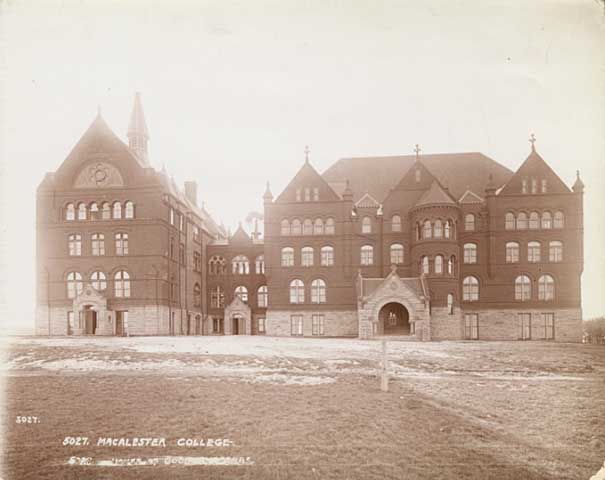 Neill had been away from St. Paul for a decade when he returned to his favorite city to begin his major life work: Formation of a college modelled on New England schools lie his own alma mater, Amherst. Twenty years earlier, he had established the Baldwin school, a preparatory seminary which originally stood near where the Landmark center is today. According to later historians, the school was upwardly mobile (literally and figuratively), changing location from St. Paul to Minneapolis and back again to St. Paul, and from seminary to college preparatory and back to high school eventually. It was named for one of Neill’s major supporters, Mathias William Baldwin of Philadelphia. A generous giver Baldwin also was a shrewd businessman, who suggested to Neill that St. Paul people should help support the new school. Neill’s response was that “there are no active wealthy Christians here….the majority of the community are professional and land speculators who care little for the future prosperity of Minnesota…The children at the school are children of poor parents…Speculative money lenders in the West seem to have no children.”
Neill had been away from St. Paul for a decade when he returned to his favorite city to begin his major life work: Formation of a college modelled on New England schools lie his own alma mater, Amherst. Twenty years earlier, he had established the Baldwin school, a preparatory seminary which originally stood near where the Landmark center is today. According to later historians, the school was upwardly mobile (literally and figuratively), changing location from St. Paul to Minneapolis and back again to St. Paul, and from seminary to college preparatory and back to high school eventually. It was named for one of Neill’s major supporters, Mathias William Baldwin of Philadelphia. A generous giver Baldwin also was a shrewd businessman, who suggested to Neill that St. Paul people should help support the new school. Neill’s response was that “there are no active wealthy Christians here….the majority of the community are professional and land speculators who care little for the future prosperity of Minnesota…The children at the school are children of poor parents…Speculative money lenders in the West seem to have no children.”
Baldwin school, revived in the former Winslow House – a handsome hotel near St. Anthony falls, owned by another well-to-do Philadelphian, Charles Macalester – was renamed Jesus college, a Christian but nonsectarian supplement to the state university. It was a financial failure and lasted only two years, with Neil and a sister paying rent and other expenses. Eventually Neill was forced to appeal to Mr. Macalester, a millionaire investor in real estate and western municipal developments. Macalester favored converting Winslow House to a hospital – “the country is swimming with educational institutions,” he wrote in June 1873. Six months later he was dead, but a codicil in his will transferred Winslow House to “Macalester College’ or its trustees, with the provision that $25,000 be raised within three years for endowment. Macalester College was chartered by the Minnesota legislature March 5th, 1874.
Ironically, as Neill’s lifelong dream became reality, his personal fortunes began to decline.
Much of his modest wealth had gone to the support of the Baldwin-Jesus venture, and for the rest of his life he would depend on his salary as a Macalester professor. Although he was Macalester’s first president, the school’s shaky finances had forced him to give up his “unsectarian” preference and yield to offers of Presbyterian patronage. Unfortunately for him, Neill had left the Presbyterian fold in the early 1870s to join the Reformed Episcopal Church, and although Dupre says he returned to Presbyterianism in 1890, Edward Neill’s will specifically that his funeral service follow the Episcopal liturgy, which it did.
By the early 1880s, Winslow House was surrounded by industrial growth, and in 1881 the college which it housed was moved to a quarter-section of land at Summit and Snelling in St. Paul. No longer president, Dr. Neill served as professor of history, English literature and political economy. (He had received an honorary doctor of divinity in 1886 from Lafayette college in Pennsylvania.) His one moment of glory came when his college had its formal opening September 16, 1885 and he gave the dedicatory address. A college, he said, was not a clubhouse for rich men’s sons nor a reform school for incorrigibles: it should be a place “to develop harmoniously the body, the intellect and the affections.”
Neill had wanted a college for men only, limited in enrollment. “Whenever an institution of learning,” he said, “becomes anxious for a long catalogue of students, there is danger of its catering to the popular taste, and lowering the standard of scholarship.” He was not happy when young women were admitted to the preparatory school in 1885 and refused to teach any class that included them.
The evils of coeducation may have been discussed on the last afternoon of his life, when he was visited by Macalester President A.W. Ringland. After seeing Dr. Ringland to the door, Neill returned to the parlor of his home at 515 Portland Ave., where Mrs. Neill, according to a news account, “saw her husband place his left hand to his forehead as though he had experienced a momentary spasm of pain.” A doctor was called, but it was too late. “Dr. Neill was told last January that he was instructed to be careful of his health.”
Newspaper obituaries gave the 70-year-old pioneer chairman-educator their most flowery prose.
Generous columns detailed his story from New England college days through the early yes in Minnesota, on to government service at home and abroad, and up to the final tributes at his funeral. The ceremony was held at little House of Hope following a private family service at the Neill home.
Officiating clergymen from Presbyterian and Episcopal churches led a procession of honorary pall bearers that included Alexander Ramsey, Gen. J. W. Bishop, Dr. J.H. Murphy, Judge W.B. Leech (formerly captain of the First Minnesota), and Major J.O. White. “It was an impressive sight as one looked about the large audience,” says one account, “to see how young and old alike, all sorts and conditions, had come together to do honor to the dead… To the many pioneers who had known Dr. Neill in the early days the thought was brought home to them that they might be the next to ‘pass to the land of shadows’. Burial was in Oakland cemetery.
More than a century after his death, Edward Duffield Neill has few lasting memorials. A St. Paul public school with his name was razed to make way for a high rise that also has his name, and the college he founded has a collection of papers that belonged to its first president and library.
And in Washington County, there is a 24-mile stretch of blacktop that crosses land its first historian knew. Appropriately, that road passes a church, organized by Missouri synod Lutherans when Edward Neil was in his prime, and a few miles north, a former country school of the kind he might once have visited. Before it ends in Stillwater, the interrupted avenue reemerges at Boutwell road, near the cemetery where another famous pioneer is buried.
It’s just too bad county maps call it “Neal”.
Material from this article was contributed by Jerry Brosious, David Stepan, and Diane Thompson.
 On Thursday, November 17th, your gift goes farther on Give to the Max Day! Organizations that raise the most money in their size brackets are granted additional cash bonuses and an extra $1,000 is added to one random donation per hour. Another boost of $10,000 will be awarded to a single donation on the 17th.
On Thursday, November 17th, your gift goes farther on Give to the Max Day! Organizations that raise the most money in their size brackets are granted additional cash bonuses and an extra $1,000 is added to one random donation per hour. Another boost of $10,000 will be awarded to a single donation on the 17th.
 Stillwater is a quiet community. Not much noise except when the bridge is open and the big trucks travel through downtown. There is not much crime and the citizens are kept safe by the ever watchful eye of the Stillwater Police Force. In the days of the lumber era, Stillwater had more than its share of gunfire and bad behavior. Even then, a murder on Main Street was headline news.
Stillwater is a quiet community. Not much noise except when the bridge is open and the big trucks travel through downtown. There is not much crime and the citizens are kept safe by the ever watchful eye of the Stillwater Police Force. In the days of the lumber era, Stillwater had more than its share of gunfire and bad behavior. Even then, a murder on Main Street was headline news.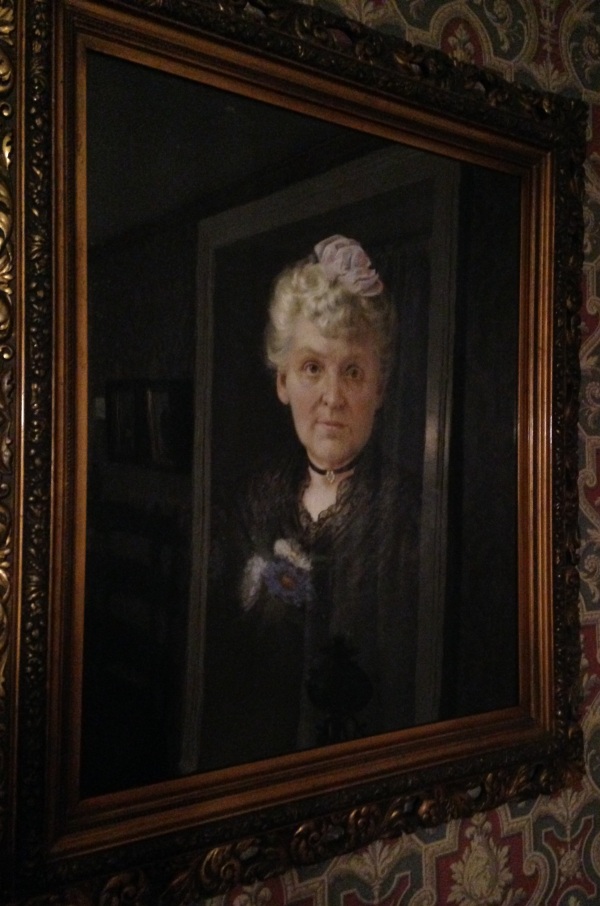 Dr. W.H. Caine, whose office was nearby, heard the shooting and rushed to the street, pushing his way into the music store. He was later joined by Dr. T.C. Clark and Dr. E. O’B. Freligh. At first the wounded Seward was to be taken to the city hospital, but Mrs. Seward arrived and had her husband transferred to their home. Local doctors remained at the Seward residence through the night, but nothing could be done to save his life. Victor Seward died the following morning.
Dr. W.H. Caine, whose office was nearby, heard the shooting and rushed to the street, pushing his way into the music store. He was later joined by Dr. T.C. Clark and Dr. E. O’B. Freligh. At first the wounded Seward was to be taken to the city hospital, but Mrs. Seward arrived and had her husband transferred to their home. Local doctors remained at the Seward residence through the night, but nothing could be done to save his life. Victor Seward died the following morning.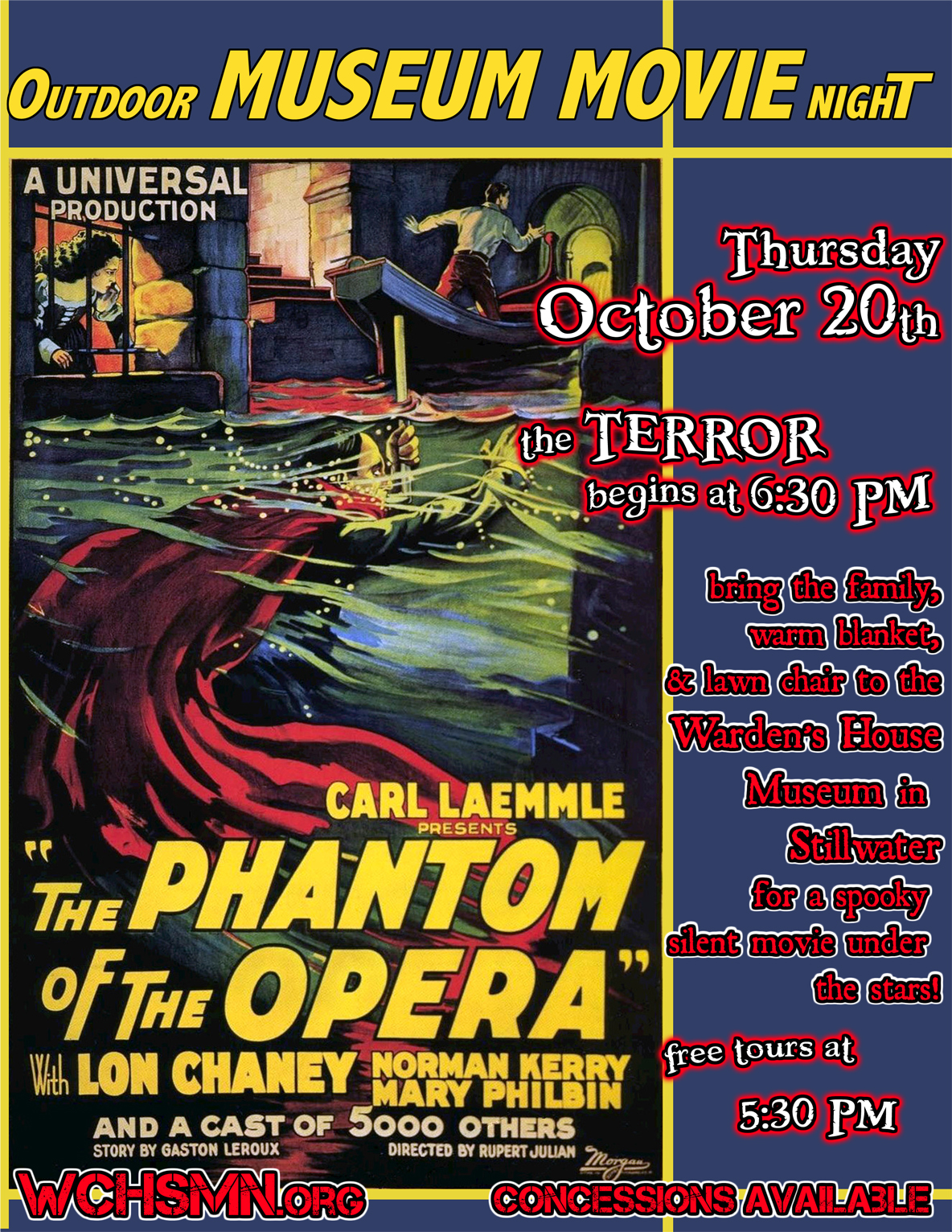

 In 1864, General Alfred Sully (pictured right) was given command of cavalry units and an artillery battery on a march through North Dakota to wreak havoc on the Dakota men, women and children who had taken refuge in the Badlands.
In 1864, General Alfred Sully (pictured right) was given command of cavalry units and an artillery battery on a march through North Dakota to wreak havoc on the Dakota men, women and children who had taken refuge in the Badlands. Although the event took place in a little Pennsylvanian town, more than a century and a half ago, Minnesotans still revere the memory of that gallant band of volunteers and the man who led the First Minnesota at the Battle of Gettysburg, Col. William Colvill.
Although the event took place in a little Pennsylvanian town, more than a century and a half ago, Minnesotans still revere the memory of that gallant band of volunteers and the man who led the First Minnesota at the Battle of Gettysburg, Col. William Colvill.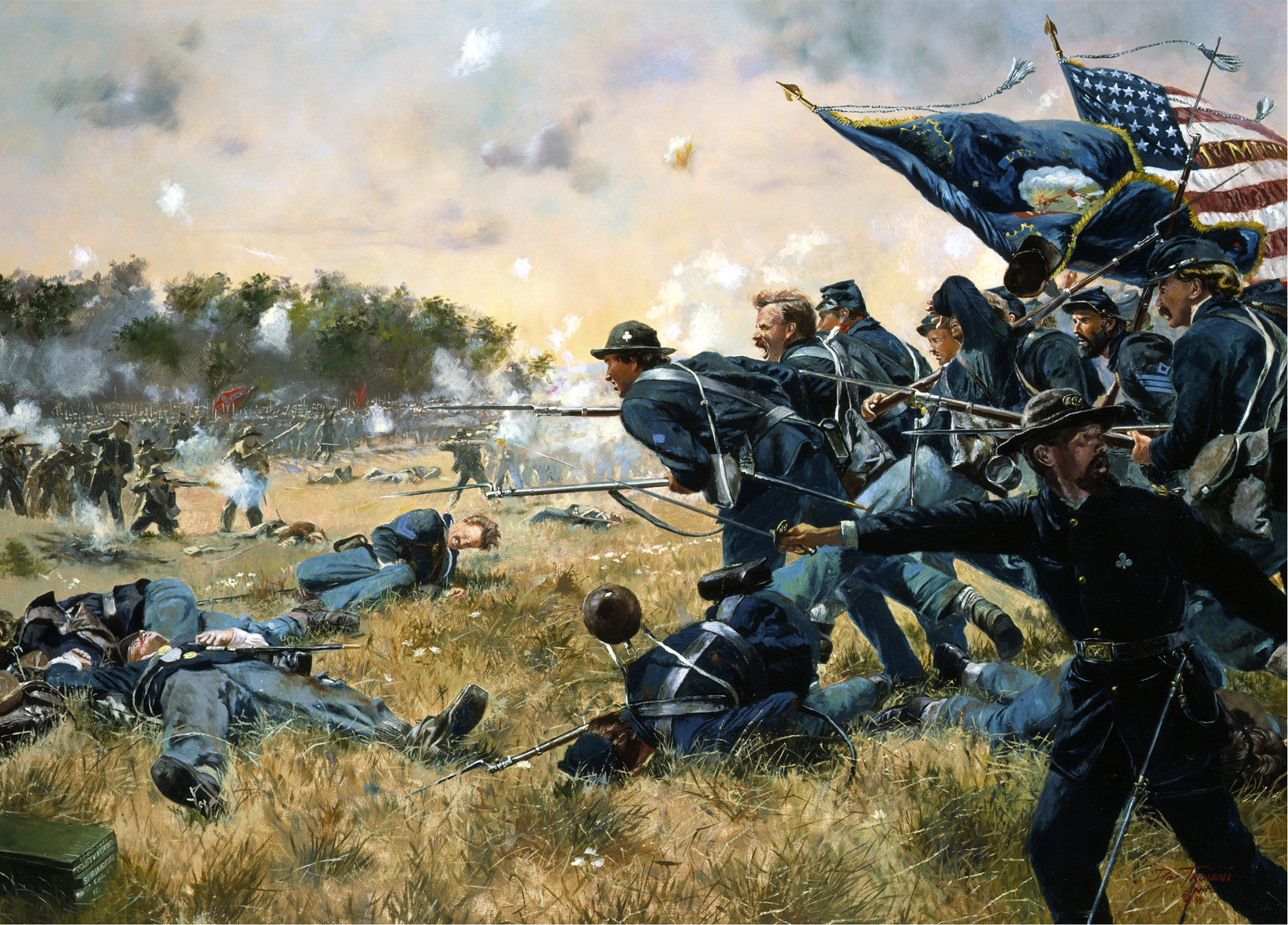 Two minutes before relief came from the New York 82nd, the colonel was wounded. He rolled into a gully where, he said, he “listened to the bullets zinging along the ground… and it grew dark and became quiet, the stars shining overhead.” He heard the sounds from the rebel line nearby.
Two minutes before relief came from the New York 82nd, the colonel was wounded. He rolled into a gully where, he said, he “listened to the bullets zinging along the ground… and it grew dark and became quiet, the stars shining overhead.” He heard the sounds from the rebel line nearby.
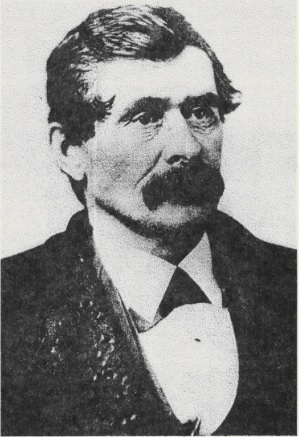 I think there’s a misconception that county historical societies are 100% and entirely focused on their small narrow pieces of local histories. And while, yes, we will chronicle the lives of our communities’ farmers, politicians, wives, and doctors…these men and women didn’t live in a vacuum.
I think there’s a misconception that county historical societies are 100% and entirely focused on their small narrow pieces of local histories. And while, yes, we will chronicle the lives of our communities’ farmers, politicians, wives, and doctors…these men and women didn’t live in a vacuum. No changes have been made in these rules for a number of years, to my personal knowledge, as I have seen copies of them dated as far back as 1905, the same as these given here which are quotes from the 18th Biennial Report of the prison for 1913-1914 recently published.
No changes have been made in these rules for a number of years, to my personal knowledge, as I have seen copies of them dated as far back as 1905, the same as these given here which are quotes from the 18th Biennial Report of the prison for 1913-1914 recently published.
 Paranormal Investigations: Techniques & Theories with the Johnsdale Paranormal Group
Paranormal Investigations: Techniques & Theories with the Johnsdale Paranormal Group
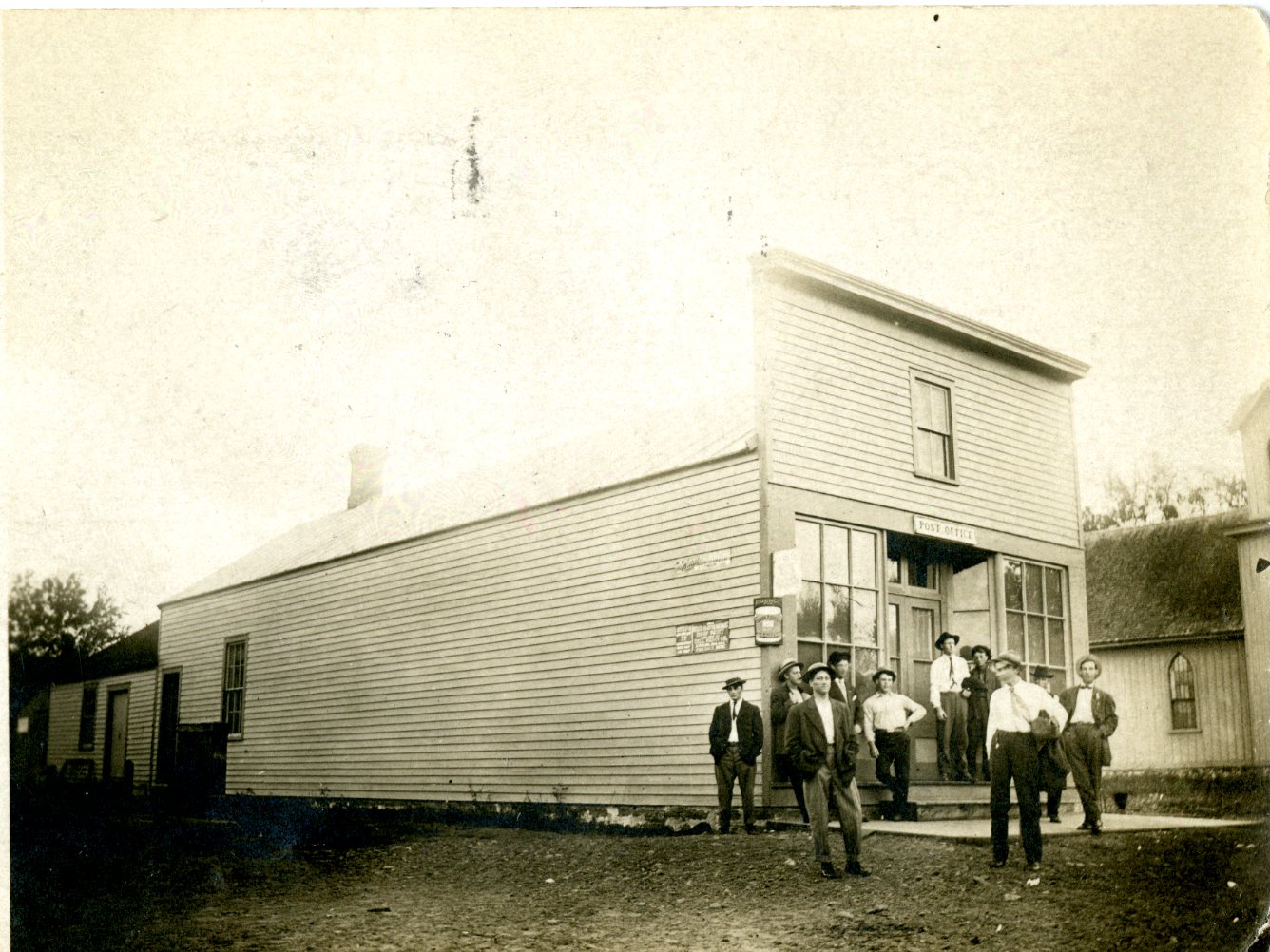 As early as 1840 a small settlement of French Canadians and their part-Indian families existed on the site of Lakeland Village along Lake St. Croix. Apparently these earliest settlers moved on, because by 1849 there were no buildings at the present village site.
As early as 1840 a small settlement of French Canadians and their part-Indian families existed on the site of Lakeland Village along Lake St. Croix. Apparently these earliest settlers moved on, because by 1849 there were no buildings at the present village site.


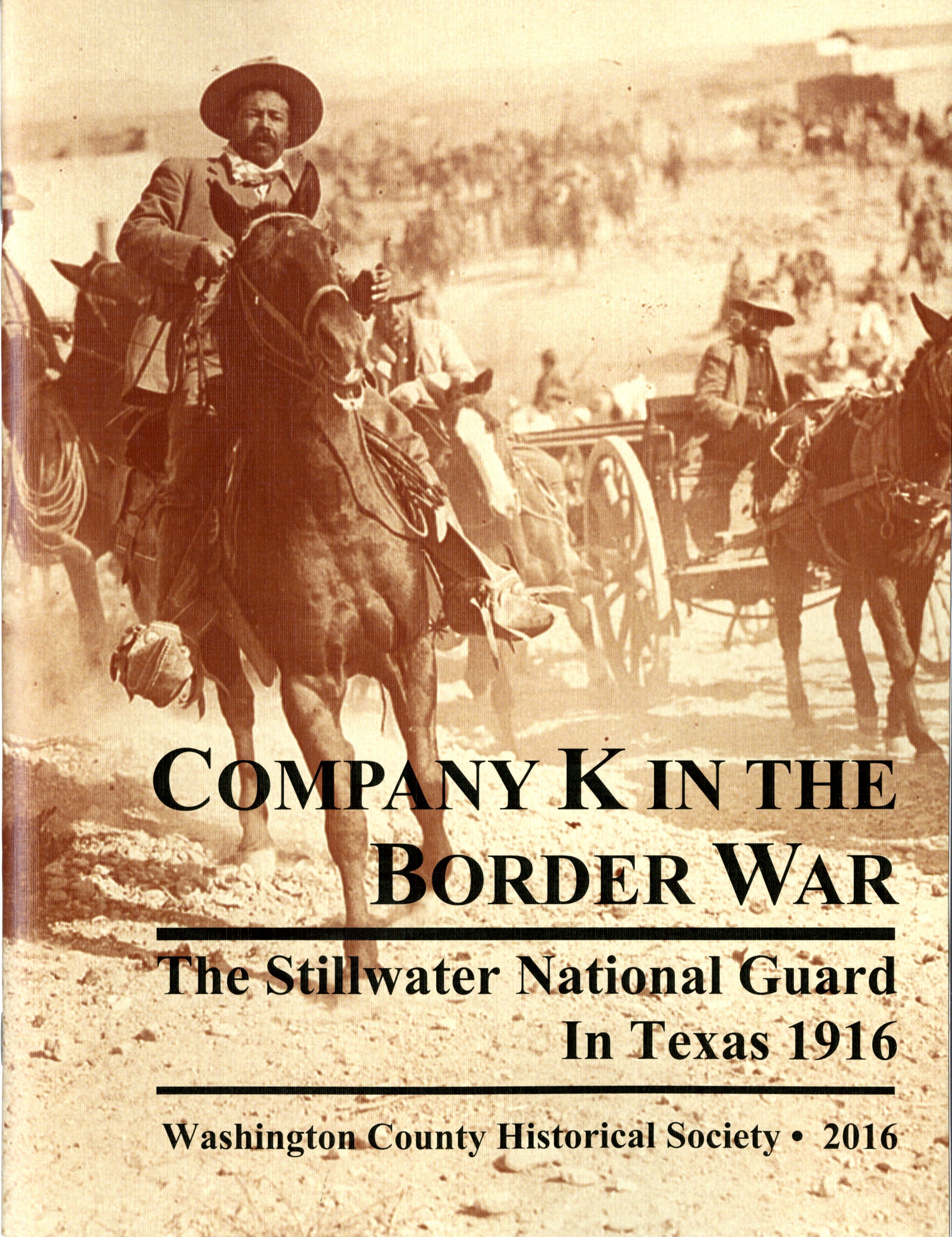
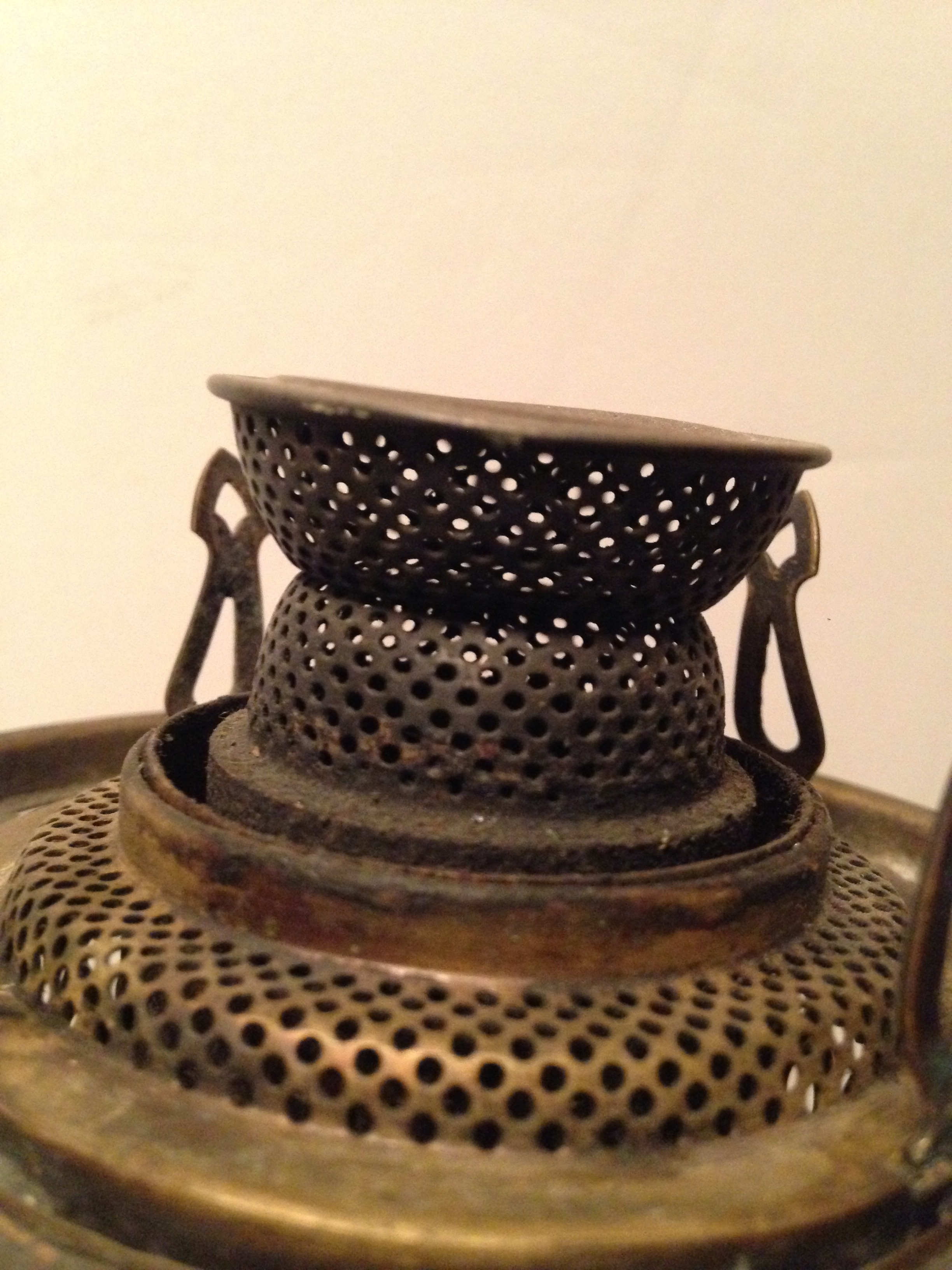
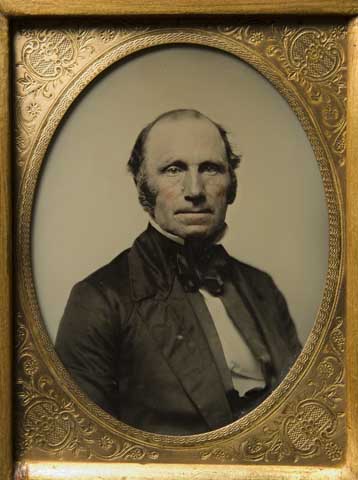 Last evening our entire community was startled by the announcement of the sudden and unexpected death, in a fit of apoplexy, of Gov. Holcombe, the present Mayor of our city. The sad event occurred at about 9 o’clock last (Monday) evening. He was with his family were setting in his room, when he thought he heard some one driving around his house, whom he supposed to be his nephew Willie Holcombe, and he went to the door to let him in, when he observed a cow that had by some means found her way into his yard. Going out he drove the cow out of the yard and was returning to the house when he was taken and it is supposed remained some ten or fifteen minutes before he was found. His family were attracted to this pot, which was in front of the house, by hearing him groan, and when they came to him asked him the matter he replied that it was one of his old attacks, “God have mercy on my soul,” and expired immediately.
Last evening our entire community was startled by the announcement of the sudden and unexpected death, in a fit of apoplexy, of Gov. Holcombe, the present Mayor of our city. The sad event occurred at about 9 o’clock last (Monday) evening. He was with his family were setting in his room, when he thought he heard some one driving around his house, whom he supposed to be his nephew Willie Holcombe, and he went to the door to let him in, when he observed a cow that had by some means found her way into his yard. Going out he drove the cow out of the yard and was returning to the house when he was taken and it is supposed remained some ten or fifteen minutes before he was found. His family were attracted to this pot, which was in front of the house, by hearing him groan, and when they came to him asked him the matter he replied that it was one of his old attacks, “God have mercy on my soul,” and expired immediately. 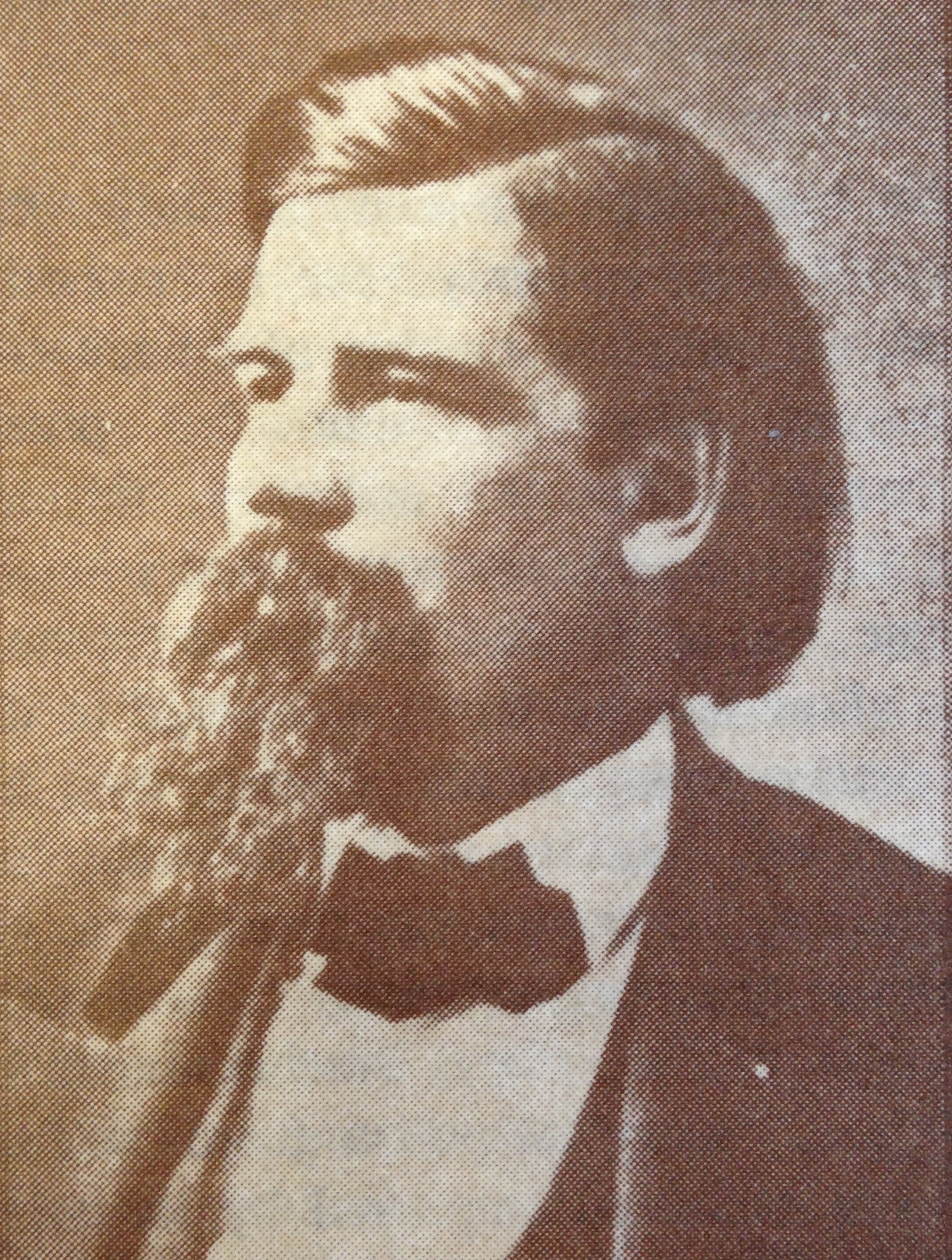 Dwight Sabin was born at Marseilles, Illinois on April 25, 1843. His father, Horace Carver Sabin, had large farm operations and a lumber business. He was an abolitionist, said to have been acquainted with Abram Lincoln, and even operated a station on the Underground Railroad. In 1856, the family returned to Connecticut, where his father was born and where the Sabin family had settled in 1740, from Scotland.
Dwight Sabin was born at Marseilles, Illinois on April 25, 1843. His father, Horace Carver Sabin, had large farm operations and a lumber business. He was an abolitionist, said to have been acquainted with Abram Lincoln, and even operated a station on the Underground Railroad. In 1856, the family returned to Connecticut, where his father was born and where the Sabin family had settled in 1740, from Scotland.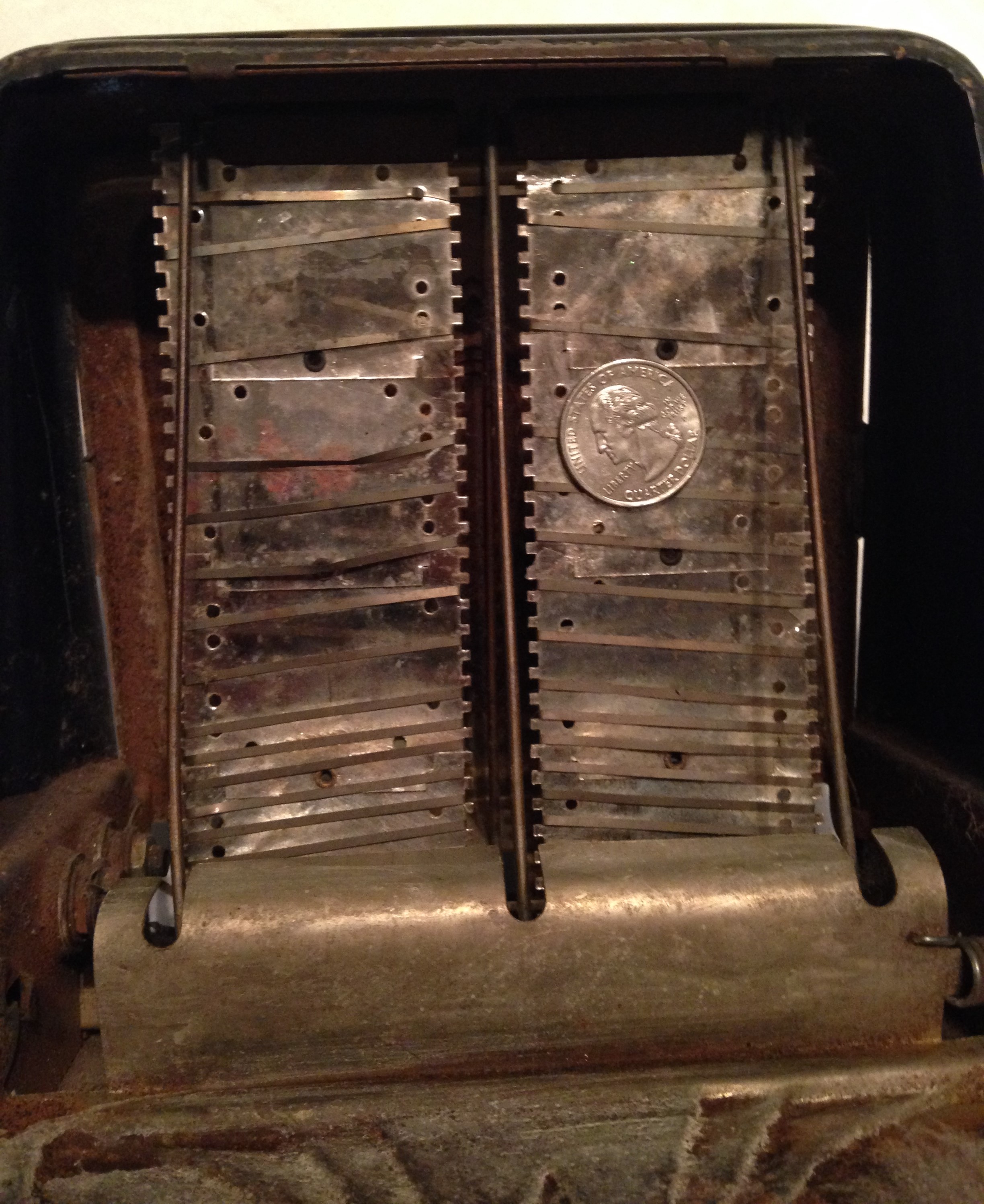
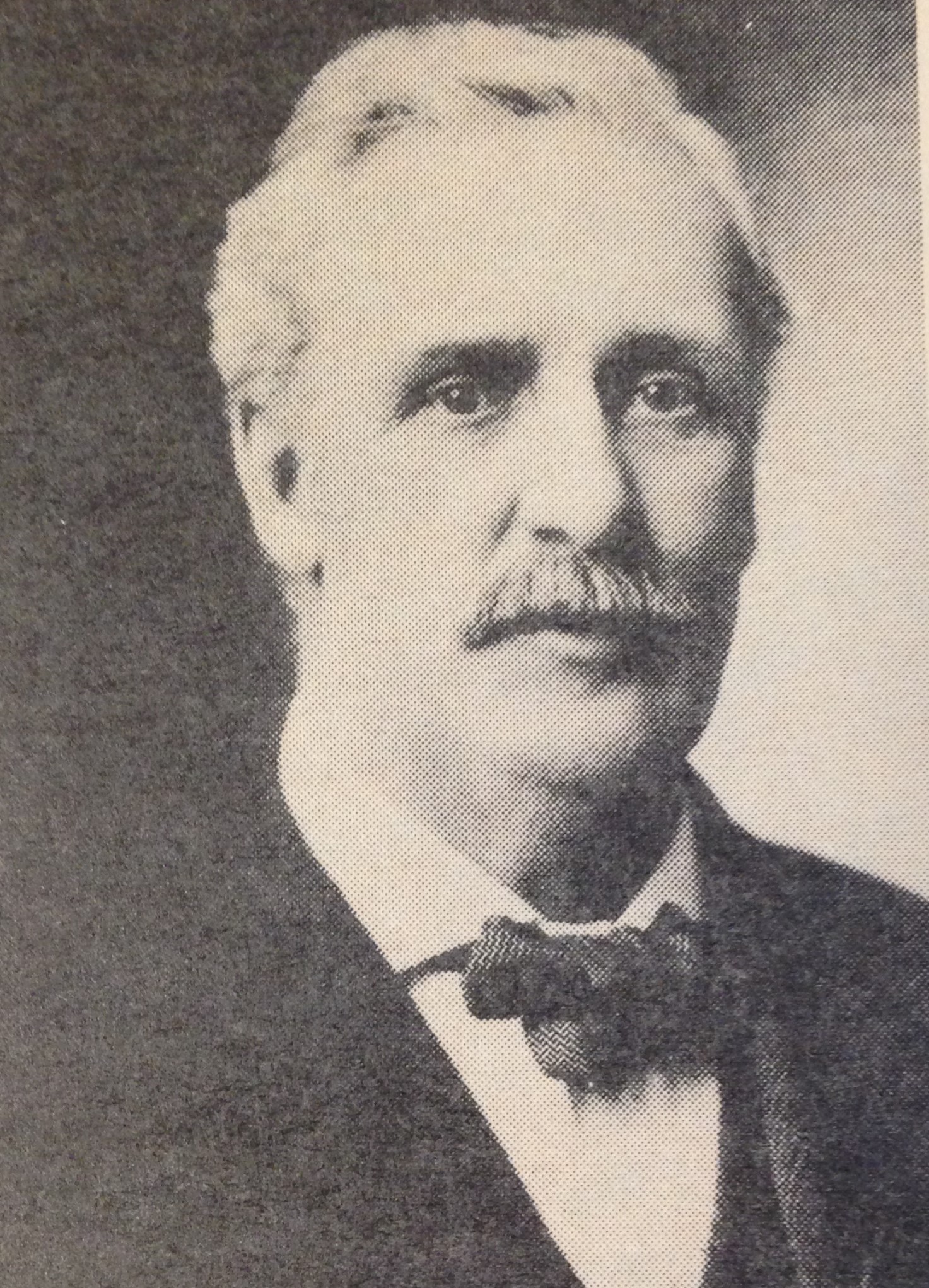



 Beginning in Denmark Township at the southern tip of Washington County, a road hopscotches north until it halts in Stillwater Township a few miles beyond Minnesota Hwy 96. Its original name some say, was “Prairie”. Its present name was chosen in the late 1960s, when the alphabetical Capitol grid plan became effective. That’s when some non-historian labeled it “Neal Avenue”. It means nothing except that it follows Manning and precedes Oakgreen. And yet, it could mean a great deal, spelled differently, but pronounced the same.
Beginning in Denmark Township at the southern tip of Washington County, a road hopscotches north until it halts in Stillwater Township a few miles beyond Minnesota Hwy 96. Its original name some say, was “Prairie”. Its present name was chosen in the late 1960s, when the alphabetical Capitol grid plan became effective. That’s when some non-historian labeled it “Neal Avenue”. It means nothing except that it follows Manning and precedes Oakgreen. And yet, it could mean a great deal, spelled differently, but pronounced the same. Neill had been away from St. Paul for a decade when he returned to his favorite city to begin his major life work: Formation of a college modelled on New England schools lie his own alma mater, Amherst. Twenty years earlier, he had established the Baldwin school, a preparatory seminary which originally stood near where the Landmark center is today. According to later historians, the school was upwardly mobile (literally and figuratively), changing location from St. Paul to Minneapolis and back again to St. Paul, and from seminary to college preparatory and back to high school eventually. It was named for one of Neill’s major supporters, Mathias William Baldwin of Philadelphia. A generous giver Baldwin also was a shrewd businessman, who suggested to Neill that St. Paul people should help support the new school. Neill’s response was that “there are no active wealthy Christians here….the majority of the community are professional and land speculators who care little for the future prosperity of Minnesota…The children at the school are children of poor parents…Speculative money lenders in the West seem to have no children.”
Neill had been away from St. Paul for a decade when he returned to his favorite city to begin his major life work: Formation of a college modelled on New England schools lie his own alma mater, Amherst. Twenty years earlier, he had established the Baldwin school, a preparatory seminary which originally stood near where the Landmark center is today. According to later historians, the school was upwardly mobile (literally and figuratively), changing location from St. Paul to Minneapolis and back again to St. Paul, and from seminary to college preparatory and back to high school eventually. It was named for one of Neill’s major supporters, Mathias William Baldwin of Philadelphia. A generous giver Baldwin also was a shrewd businessman, who suggested to Neill that St. Paul people should help support the new school. Neill’s response was that “there are no active wealthy Christians here….the majority of the community are professional and land speculators who care little for the future prosperity of Minnesota…The children at the school are children of poor parents…Speculative money lenders in the West seem to have no children.”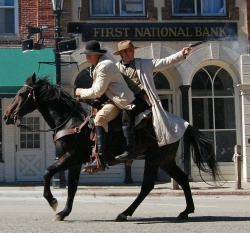 The Story of the Northfield Raid
The Story of the Northfield Raid



 “Girl from Birch Creek” Screening
“Girl from Birch Creek” Screening “The Perilous St. Croix River Valley Frontier”
“The Perilous St. Croix River Valley Frontier”
 There are many people who affect our lives. They could be our parents, siblings or neighborhood friends. Most of the time as we recall our lives we are touched by at least one, maybe more, of our teachers in school.
There are many people who affect our lives. They could be our parents, siblings or neighborhood friends. Most of the time as we recall our lives we are touched by at least one, maybe more, of our teachers in school. Roxy was the first manager of Radio City Music Hall in New York City and one of his lasting efforts was to take a dance line from Russell Markert of Missouri called the “Missouri Rockets,” and renamed the line the “Roxyettes,” now world famously known as the “Rockettes.”
Roxy was the first manager of Radio City Music Hall in New York City and one of his lasting efforts was to take a dance line from Russell Markert of Missouri called the “Missouri Rockets,” and renamed the line the “Roxyettes,” now world famously known as the “Rockettes.”
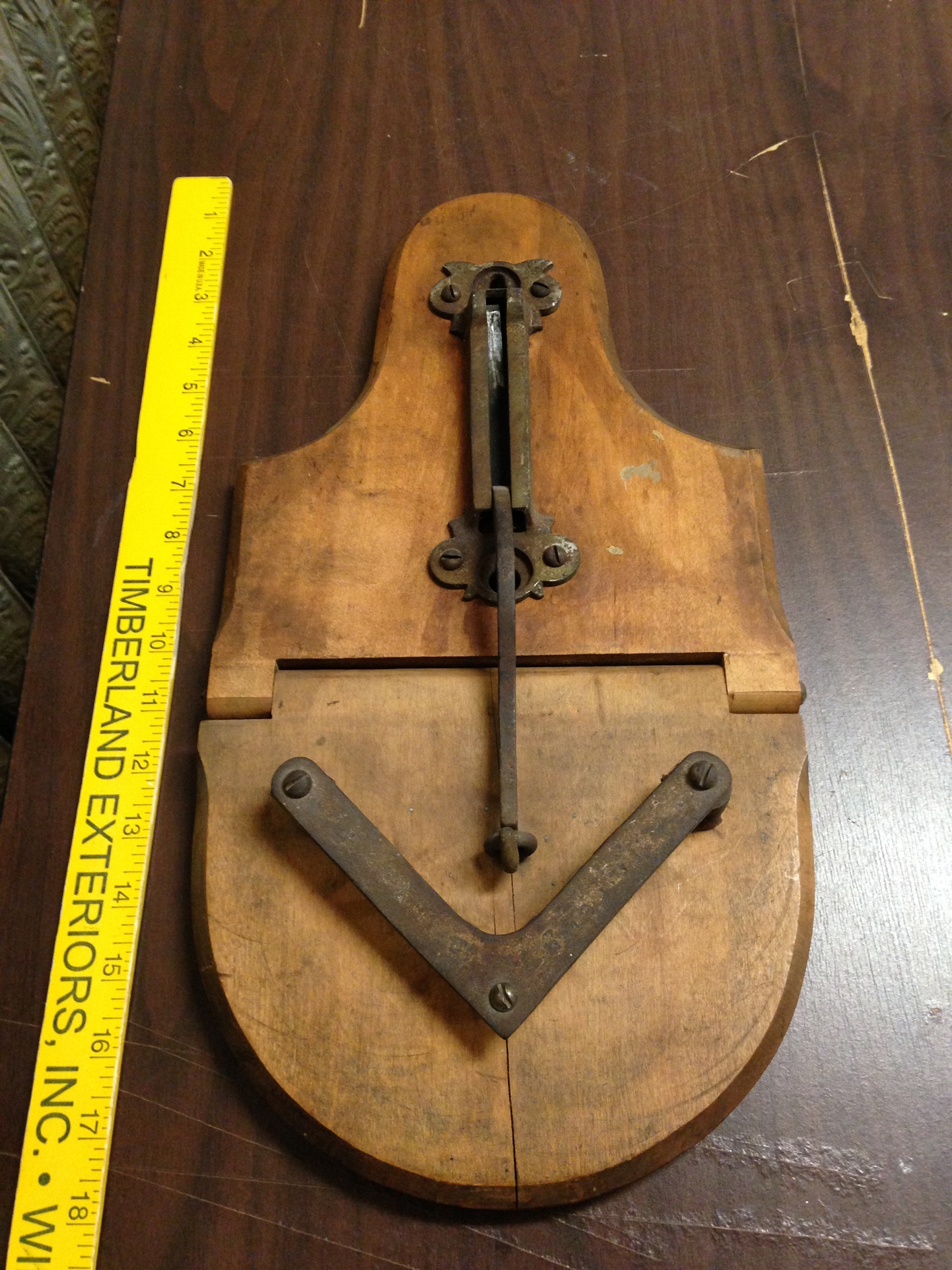
 The gravestone is plain, a small rectangle of granite, set alone near the tool shed in St. Michael’s Cemetery in Bayport. The inscription is a simple one: “Mary Traveler 1852-1888”. The story it tells is brief – that of a young woman who lived a mere 36 years. (Photo by Ken Martens)
The gravestone is plain, a small rectangle of granite, set alone near the tool shed in St. Michael’s Cemetery in Bayport. The inscription is a simple one: “Mary Traveler 1852-1888”. The story it tells is brief – that of a young woman who lived a mere 36 years. (Photo by Ken Martens)